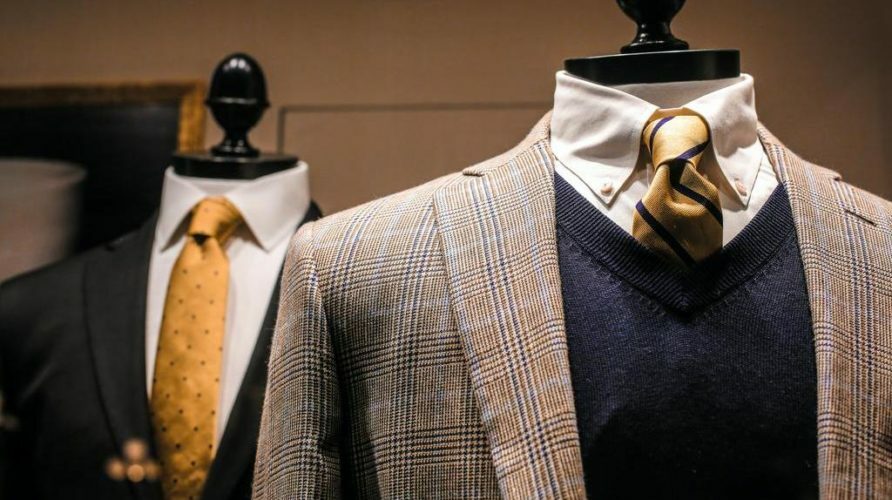The modern men’s suit ensemble is rarely considered complete without the necktie. Perhaps the most important suit accessory in a man’s wardrobe, the steadfast necktie carries a long and proud tradition throughout history, with its function and form evolving over time to encompass a variety of roles. Well-Sewn looks to chronicle the history of the necktie and its evolution with a retrospective look at how the accessory has been utilized in different time periods, ranging from a vital piece of protection from the elements for some to a fashion statement for others. Join us as take a deep dive into the history of the necktie…
Early History: A Source of Protection
Neckwear for men is thought to have emerged during the ancient period, specifically among soldiers looking to protect themselves from the elements. Roman soldiers are known to have begun having worn heavy bands of cloth wrapped around their necks and under their armor to provide warmth and to add a layer of protection for the vital throat area around the second century A.D. As many of the Roman military campaigns during this period were focused in central and northern Europe among the Germanic tribes, the harsher continental climates the soldiers found themselves forged the usage of neckwear out of necessity.
A similar methodology would be discovered by archaeologists in the Chinese city of Xi’an. Excavations dating back to the 3rd century B.C. depict terra-cotta statues of soldiers wearing neck scarves around their throats. It is believed that these statues reflect the soldiers protecting the Adam’s apple, which was thought to be the source of their strength during that period of history. These historical appearances of neckwear demonstrate the early importance to soldiers, but it would take many more centuries before the forerunners to our modern neckties would begin to make an appearance as a choice of fashion rather than necessity.
17th Century: The Rise of Cravats
The next stage in the evolution of neckwear would also come about through the advance of soldiering. During the Thirty Years’ War (1618-1648), King Louis XIII of France hired a group of mercenaries from Croatia that wore as part of their ensemble knotted neckerchiefs that caught the attention of the Parisians. So taken by the style was the king’s heir apparent, the soon-to-be Louis XIV that when he began wearing jabots made of lace, it set off a fashion frenzy amongst the French nobility. Through a portmanteau of the Croatian and French words for ‘Croats’ came the new term for the garment, the cravat – the forerunner to modern neckties.
Cravats would wax and wane in popularity over the ensuing two centuries, with intermittent revivals in popularity coming about, especially at the turn of the 19th century. From the development of the cravat came similar neckwear including the stock tie, usually worn as a narrow piece of muslin fabric held together with a special pin. Scarves began to find widespread usage during this time period as well, with cotton, lace and even silk being commonly used in the material. As the industrial revolution emerged in Western Europe however, demand began to arise for a new form of neckwear that was better suited for the changing workplace. This would set the stage for a radical new invention in neckwear.
19th Century: The Four-in-Hand Appears
By the mid-19th century, cravats and stock ties had become more of an upper-class fashion item and were less and less in use by the common masses. As the century had progressed, cravats had begun being tied off into bows, which slowly evolved into what we would now consider the modern bowtie. The color patterns of bowties and stocks changed frequently during this period as well, with alternating preferences between black and white ties for daytime and formal wear changing off until color proliferation began to explode towards the end of the century. While the upper classes still considered cravats and stocks to be suitable formal attire, others such as the Romanticists considered them outdated throwbacks.
Ascot ties also appeared during this period, a style that survives today in many formal and military settings (U.S. sailors wear ascots with their dress blues and whites to this day). It was popular novelist Charles Dickens of all people that introduced a new style of neckwear on an 1867 tour of the United States: wearing his collar down with an unknotted cravat held in place by a seal ring, Dickens was in effect creating an early version of the four-in-hand knot. This version of the necktie was popularized by coach drivers who slip-knotted their cravats to prevent them from blowing in the wind while driving their horse carriages. By the turn of the 20th century, the four-in-hand tie knot had become pervasive among tie wearers around the world.
20th Century: The Modern Tie Emerges
The advent of the industrial revolution had led to a rise in demand for a new type of neckwear: comfortable, easy to maintain ties that would not easily come undone and that had a stronger emphasis on functionality rather than formality. As ascots and cravats faded from usage, the four-in-hand tie knot gave rise to the modern tie as we know it today. By the turn of the 20th century, ties were beginning to appear in a variety of colors and lengths. Bowties began to replace the cravat in formal settings, a trend which continues on to the current day. In the 1920s, a haberdasher from New York named Jessie Langsdorf created a new method of cutting fabric for ties which allowed the ties to return to their original shape after being untied, helping form the basis for what would become the modern trends in necktie wear.
Neckties became bolder and more colorful in the 1920s and ‘30s in keeping with the fashion and style of the times, though the Great Depression and World War II would offset this new wave of innovation (the 1930s did see the origination of the Windsor knot, however). Ties of this period were worn shorter than are traditionally worn today, a trend that would begin to reverse in the 1950s and ‘60s. The advent of ‘skinny’ ties in the 1950s coincided with a boom in bold pattern design. Tie lengths began increasing as men wore their trousers lower towards the hips in the 1960s, and wider ties known as ‘Kipper’ ties became popular with patterns embodying the ‘flower power’ spirit of the decade. Leisure suites with open-neck shirts led to a decline in necktie usage during the ‘70s, but a resurgence during the 1980s set the pattern that would continue to hold into the 21st century.
21st Century: The Next Evolution in Ties
Neckties have begun to correlate to the historical era in which they appear, with different eras producing different styles and varieties. Over the last four decades the major trends in neckties have revolved around widths and lengths, with the 1.5-to-3.25-inch width ties of the 1980s and 1990s increasing to 3.25 to 3.75 inches by the early 2000s. Most tie lengths measure in at around 57 inches, though shorter ties with widths under three inches have begun to be favored by younger men. Ecological concerns have begun to impact the fashion industry, with resource-conscious buyers being as concerned with how their ties are made as they are their appearance or their comfort. Some neckties today are even made from reprocessed tire rubber.
At the turn of the 21st century, many scholars began to openly question whether the necktie would survive the next one hundred years. With the advent of new accessories in men’s fashion, the existence of the necktie as the centerpiece statement of a man’s suit accessorizing was in question. If the first decades of the century are any indication however, new trends in tie development and the continued desire to look crisp in a fashionable suit will continue to push hundreds of millions of ties out to consumers for some time to come.



